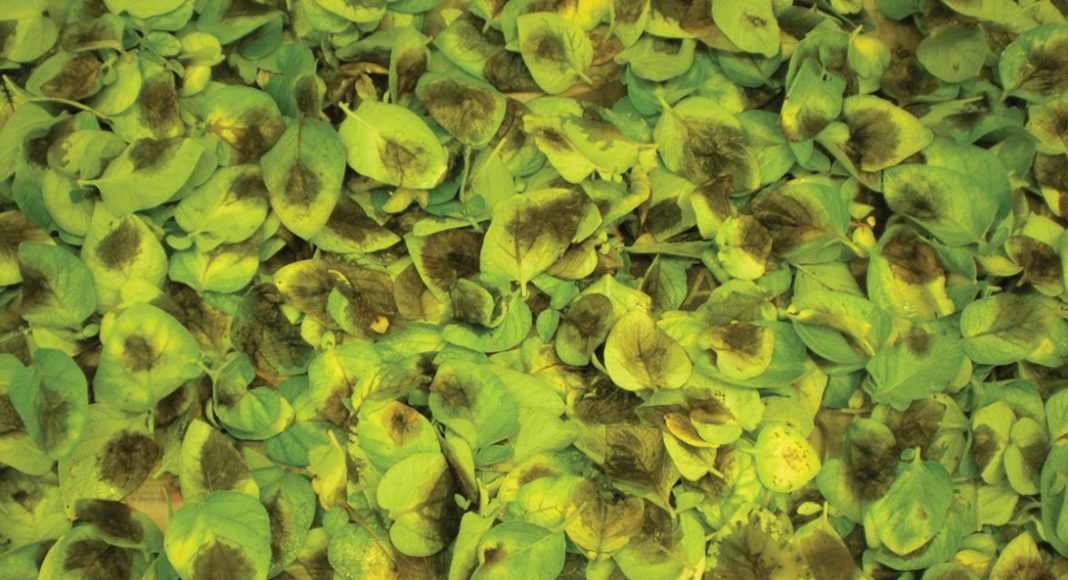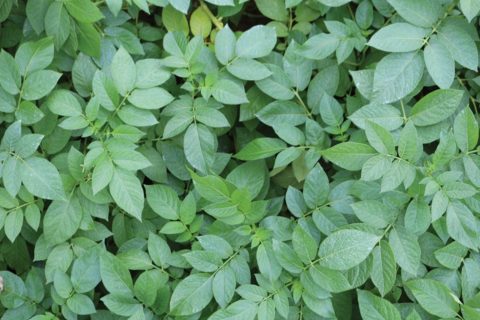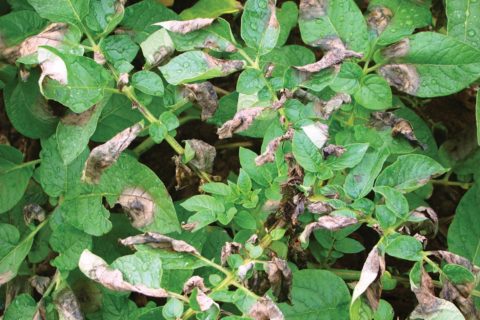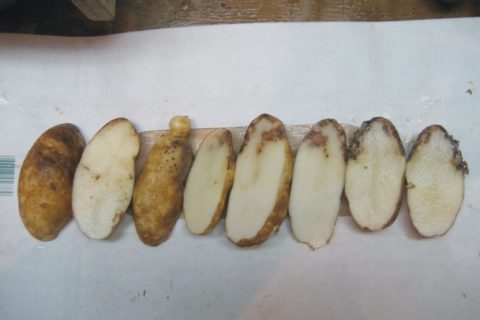We put the question of best management practices for preventing or reducing potato crop damage from late blight to three experts: Gary Secor, a North Dakota plant pathologist who dispensed advice on managing late blight to growers at the Ontario Potato Conference in March, and two McCain Foods agronomists, Monica Everett and Gilles Moreau, who regularly help growers do battle with the disease.When it comes to potato diseases, late blight is one of the biggest headaches for producers. And for good reason — the fungal disease attacks both tubers and foliage, and is a threat at every stage of production from field to storage. New strains have emerged in recent years that are resistant to conventional fungicide treatments, and it’s been spreading to parts of Western Canada that until a few years ago were virtually blight-free.
Starting Early
“Late blight is such an explosive disease because it produces a huge number of spores every five to seven days when conditions favour disease (cool and wet),” says Secor. “If you don’t manage it early and disease gets established, it is almost impossible to stop because the disease pressure is so high. And the spores can move for many miles in thunderstorms to infect neighbouring fields.”
Everett agrees that early intervention is crucial: “Prevention is critical in managing any disease and late blight is no exception,” she says. “These steps that growers take will determine the path that the disease develops. From the start of the season growers must reduce the risk at every point even before even the plant emerges, such as eliminating cull piles as sources of inoculum. One misstep is all it takes for the disease to get established.”
Moreau maintains late blight is always a threat for growers to some degree, making preventative measures all that much more important. “These spores move around without making any distinction of parishes, counties, states or countries. There are no borders for late blight spores. They move freely,” he says.
“I always take for granted that spores [are there] … whether the spores come from cull piles or whether the spores come a low pressure system that is moving alongside the Eastern Seaboard. To me, late blight spores are present on an annual basis.”
The Right Seed
“Late blight only survives in living plants, so for potato growers the initial inoculum survives from one season to the next in seed, cull piles and volunteers; of these, seed is the most important source of early inoculum and infection,” says Secor. “So planting seed free of late blight is important to prevent early disease outbreaks.”
In addition to planting disease-free seed, using seed treated with protectants against late blight can also reduce risk. Everett and Moreau recommend the use of seed piece treatments to prevent tuber-to-tuber spread, and Secor points out that there are some new seed treatments registered recently in Canada that can help reduce the spread of late blight during cutting.
Applying Fungicide
The experts agree that once late blight is present in a field, there’s really only one way to tackle the disease at that point: spray the crop with fungicide, and repeat as often as necessary.
“Once disease is present, fungicide applications are the only way to manage late blight in the field,” Secor says. “Scouting and knowing proper fungicide application are important to stop or slow early infections before they become serious.”
Everett and Moreau stress that when spraying fields, growers need to be mindful of the following:
- Using the right product (different products have different strengths)
- At the right time
- And at the right rate
Everett says that in order to be effective against late blight, fungicides need to be applied at the proper rate. “Different labels will have different application rates, and we do recommend that our growers go in [using the] full rate at any time throughout the growing season,” she says.
Moreau stresses the importance of starting a spray program before any disease symptoms develop, because when it comes to this aspect of late blight prevention, timing is everything.
“Probably the most important thing for late blight prevention is applying the protection to the crop to protect the new growth as close as possible to just before the infection event,” says Moreau.
“The question I put to growers is, ‘When do you put on your sunscreen? Do you put it on before you go out in the sun, or do you put it on after you’re burnt?’ Obviously, the answer is simple — you put it on before you go out in the sun. The same applies to fungicide for late blight protection.”
Watch the Weather
The best conditions for late blight infection are cool, wet weather, and the spread of the disease is often associated with frontal system movements. For this reason, it is important for growers to keep a close eye on the weather.
“Watching the weather to know when conditions are favourable for late blight spread and infection … is helpful. Paying attention to regional late blight forecasts and updates should be done often during the season,” says Secor. “And it is always good to get education and training on late blight identification and management from local experts.”
Growers affiliated with McCain Foods have the benefit of a system that helps McCain agronomists assess the risks associated with late blight infection events and offer recommendations on the best protectants to use.
The Dacom Agri Yield Managment system is part of an Integrated Pest Management initative from McCain. It collects and analyzes weather and environment data, which can be used to assess late blight infection risks in specific regions. Another tool called the EuroBlight Fungicide Table helps determine the optimum product for different stages during potato plant growth.
“We basically put out a recommendation to our growers, based on the Dacom support system as well as the EuroBlight Fungicide Table for selection of fungicide [application],” says Everett.
Moreau points out the final decision is always up to the farmer. “It’s not a decision-making system; it provides guidance for the decision-making process,” he says. “That’s important to understand.”
Know the Strain
Everett and Moreau strongly recommend testing if late blight symptoms show up, to determine which strain of the disease is present locally.
“As an industry we need to track the development of the disease and be aware of products that work best against different strains. We can also track the movement of the disease if it is reported,” Everett says, adding that testing provides direct benefits to the farmer.
“Knowing what you’re dealing with will help you in being able to control it. If you don’t know what you have, it’s very difficult to try to develop a control program,” she adds. Moreau agrees that “knowing the strain will allow you to fine-tune your strategy.”
A Community Problem
Moreau says late blight is “a disease that has to be treated and approached on a community basis.”
Everett agrees. “If a grower finds late blight, they should let your neighbour’s know so they can adjust their spray programs,” she says. “It’s not an individual problem. It is a problem for all of the grower community.”














